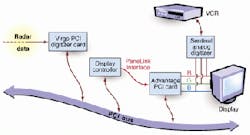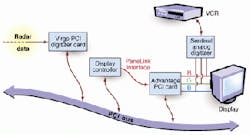Digitizers mix radar and graphics
In many military and medical applications, video, graphic, and text data are mixed at various stages to produce a final image on a high-resolution monitor. In military and aerospace applications, for example, radar data have to be changed to raster format using a scan converter while a standard graphics card generates overlay and underlay graphics. After these data are combined, the resulting image is then shown in red-green-blue (RGB) format on the display. To record radar and graphics data, images must be digitized from the RGB output driving the monitor.
Since these noninterlaced images are often greater than 1280 x 1024 pixels, this task requires special PCI- or VME-based boards. In the design of a ship's data recorder, for instance, Consilium Navigation AB (Stockholm, Sweden) engineers chose the Hi-Def Accura frame-grabber board from Foresight Imaging (Chelmsford, MA). This board digitizes 1280 x 1024 x 85-Hz radar images every 15 s. After the images are captured, they are stored in 4 Mpixels of on-board memory and then transferred to system memory across the PCI bus (see Vision Systems Design, July 2000, p. 39).
In many aerospace applications, radar data are digitized, scan converted, mixed with graphical data, and displayed. To record this RGB data, Primagraphics has developed the Sentinel, an RGB digitizer that allows high-resolution 1600 x 1280 pixels at 75 MHz to be transferred to standard VCR cassettes.
In radar and medical-system applications, many images are greater than 1280 x 1024 pixels and are often as large as 2k x 2k pixels and must be digitized at fast rates. To address these issues, Primagraphics (Royston, Hertfordshire, England) has introduced the Sentinel, an image-capture and playback unit that can capture images as large as 1600 x 1200 pixels at 75 MHz.
Available as a VME board in a 19-in. rack-mounted version or a stand-alone unit, the imaging unit converts images into either NTSC or PAL format, with each pixel in the original image being represented by one or more pixels in the output frame. These images can then be stored in a standard video-cassette recorder.
Upon playback, the recorded video is passed to the Sentinel replay unit—a second VME board or stand-alone unit—that captures the PAL/NTSC format signal. Using encoded information in this signal, the original image is reconstituted and then presented on the Sentinel display controller as a high-resolution frame that can be displayed on a standard display monitor. The operation of the replay unit is controlled through a menu interface displayed on the output monitor.
"In one of our typical radar systems," says John Shave, managing director of Primagraphics, "a Virgo PCI card is connected to the incoming radar data stream. It transfers the digitized data across the PCI bus to the Advantage board, where it is scan-converted to raster format." The PC then generates overlay and underlay graphics data using a standard PCI-based graphics card fitted with a Panel Link output. The Advantage board then combines this graphics with the radar data and outputs it in RGB format to a high-resolution monitor.
"By capturing RGB data directly from the Advantage card using the Sentinel recorder," says Shave, "no radar or graphics data are lost." Currently capable of digitizing 1600 x 1200 images at 75 MHz, the company is looking at higher-resolution versions. According to Shave, these could be commercialized later in the year if there is market demand.

